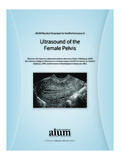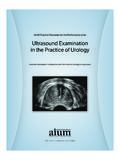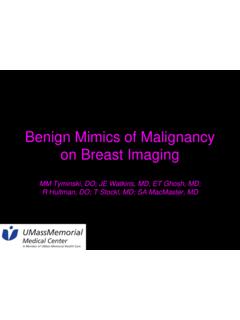Transcription of Selected Ultrasound-Guided Procedures - AIUM
1 AIUM Practice Parameter for the Performance of Selected ultrasound -GuidedProcedures 2014 by the American Institute of ultrasound in Medicine 12/1/15 4:51 PM Page 1 The American Institute of ultrasound in Medicine (AIUM) is a multidis-ciplinary association dedicated to advancing the safe and effective use ofultrasound in medicine through professional and public education,research, development of parameters, and accreditation. To promote thismission, the AIUM is pleased to publish this AIUM Practice Parameter forthe Performance of Selected Ultrasound-Guided Procedures . We areindebted to the many volunteers who contributed their time, knowledge,and energy to bringing this document to that participated in developing this document, formallyapproved it, or endorsed it include the American Association of ClinicalEndocrinologists (AACE), the American Academy ofOtolaryngology Head and Neck Surgeons (AAO-HNS), theAmerican Academy of Pain Medicine (AAPM), the American Academyof Physical Medicine and Rehabilitation (AAPMR), the AmericanOsteopathic College of Radiology (AOCR), the American PhysicalTherapy Association (APTA), the American Registry for DiagnosticMedical Sonography (ARDMS), the American Society of EndocrinePhysician Assistants (ASEPA), the American Association of NurseAnesthetists (AANA), and the American Medical Society of SportsMedicine (AMSSM).
2 The AIUM represents the entire range of clinical and basic scienceinterests in medical diagnostic ultrasound , and, with hundreds of vol-unteers, the AIUM has promoted the safe and effective use of ultra-sound in clinical medicine for more than 50 years. This document andothers like it will continue to advance this mission. These practice parameters of the AIUM are intended to provide themedical ultrasound community with parameters for the performanceand recording of high-quality Ultrasound-Guided Procedures . Theparameters reflect what the AIUM considers the minimum criteria forthe Ultrasound-Guided Procedures addressed in this document but arenot intended to establish a legal standard of care. AIUM-accreditedpractices are expected to follow the parameters with recognitionthat deviations from these parameters will be necessary in somecases, depending on patient needs and available are encouraged to go beyond the parameters to provideadditional services and information as Sweitzer Ln, Suite 100 Laurel, MD 20707-5906 USA800-638-5352 2014 by the American Institute of ultrasound in Medicine 12/1/15 4:51 PM Page clinical aspects of this parameter (Introduction; Supervision, Performance, andInterpretation of the Ultrasound-Guided Procedure; General Specifications for Ultrasound-Guided Procedures ; and Specifications for the Individual Procedures ) were developed collab-oratively.
3 Several sections of this parameter (Qualifications and Responsibilities of Personnel;Written Request for the Ultrasound-Guided Procedure; Documentation; and Quality Controland Improvement, Safety, Infection Control, and Patient Education Concerns) vary betweenthe collaborating organizations and are addressed by each parameter has been developed to assist clinicians performing Ultrasound-Guided proce-dures. While it is not possible to address every Ultrasound-Guided procedure, adherence to thefollowing parameters will maximize procedural success and patient safety. While self-evident,all clinicians must also comply with federal and state law in the performance of ultrasound - guided and Responsibilities of PersonnelIndividuals who perform Ultrasound-Guided Procedures should be licensed clinicians whoare qualified to perform interventional Procedures within their scope of practice. ( for AIUM Official Statements, including Standards and Guidelines for theAccreditation of ultrasound Practices and relevant Physician Training Guidelines.)
4 1 4 Theyshould be familiar with the basic physical principles and limitations of ultrasound imaging asthey pertain to diagnostic examinations and interventional Procedures ; understand ultrasoundtechnology and instrumentation, power output, equipment calibration and safety; and demon-strate familiarity with the anatomic, physiologic, and pathophysiologic characteristics of theanatomic areas in which the Procedures will be ,6In addition, clinicians perform-ing ultrasound - guided Procedures should be capable of correlating complementary diagnosticimaging with ultrasound findings in the context of procedural planning and should be able todetermine when alternative modes of image guidance may be appropriate. Clinicians should provide evidence of the training and competence to perform Ultrasound-Guided Procedures successfully. The training should include the following components1 13 and contraindications for ultrasound of the normal and abnormal ultrasound appearance of tendon, nerve, arteryand vein, muscle, bone, and other tissues commonly encountered during ultrasound - guided scanning for procedural planning, transducer selection and image of relevant anatomic variations and unexpected and correlation of ultrasound images with available complementaryand diagnostic Ergonomic considerations for procedural AIUM PRACTICE PARAMETER Selected Ultrasound-Guided 12/1/15 4.
5 51 PM Page needle* or device needle or device tracking using both in-plane and out-of-planeapproaches, including the limitations of each technique and methods to optimize Recognition and management of common artifacts relevant to interventional Recognition and management of procedural of documentation and reporting of Ultrasound-Guided Procedures , includingappropriate labeling and recording of images and videos.*Although needle will be used throughout the document, the guidelines also apply to other devicesthat may be used during Ultrasound-Guided Procedures (eg, biopsy guns and catheters). Request for the Ultrasound-Guided ProcedureThe request for an Ultrasound-Guided procedure should be prepared in compliance with estab-lished guidelines and can be in a written or an electronic format.* The request must originatefrom a physician or other appropriately licensed clinician, or under the physician s or clinician sdirection.
6 The requested procedure should be clearly stated and the use of ultrasound guidancespecified and justified. In addition, the request should contain sufficient information to docu-ment the medical necessity of the procedure and allow for its appropriate performance, includ-ing but not limited to known or provisional diagnoses; relevant signs, symptoms, and medicalhistory; and/or the results of complementary diagnostic imaging . Deviation from the request-ed procedure as reflected on the written or electronic request requires appropriate documen-tation by the providing the performing clinician is also the referring clinician, the required documentation may becompleted through appropriate documentation in the patient s medical record or by generat-ing a formal written or electronic request as dictated by practice-specific requirements. * Ultrasound-Guided anesthesia as part of an operative procedure may not require a written or , Performance, and Interpretation of theUltrasound- guided ProcedureAs subsequently described, a preliminary scan of the target region is completed as part of theprocedure and can be performed by the clinician performing the procedure or by a completed by a sonographer, the clinician performing the procedure is responsible for thesupervision and interpretation of the preliminary scan in the context of the planned the actual procedure, the clinician is responsible for directing the needle to the targetregion while either the clinician or a sonographer can maintain the transducer over the needlepath.
7 The procedural report should be reviewed and signed by the AIUM PRACTICE PARAMETER Selected Ultrasound-Guided 12/1/15 4:51 PM Page Specifications for Ultrasound-Guided and PersonnelThe procedure should be performed in a facility with adequate space and the necessary sup-plies and personnel for the procedure. Examples of appropriate facilities include a medicaloffice, surgical center, or hospital. Most Procedures covered in this document are consideredlow risk (for exceptions, see section IX. Specifications for Ultrasound-Guided PerineuralProcedures and Spinal Pain Procedures ; and section X. Specifications for ultrasound -GuidedFine-Needle Aspiration, Core Biopsy, and Ablative Procedures ) and may be performed aspoint-of-care Procedures in an office or surgical center setting. If a higher-risk procedure wereto be performed, it would be appropriate to perform the procedure in a location that has theability to respond to a medical Selection of the appropriate ultrasound equipment is critical for procedural may use either cart-based or portable ultrasound machines to complete aspecific procedure, depending on the procedural requirements.
8 2. Transducer choice is primarily determined by the depth of the target. For superficialstructures, a high-frequency (>10-MHz) linear array transducer is appropriate. Asmall-footprint linear array transducer is often useful to perform Procedures in smallerregions with irregular contours, such as the head and neck, wrist-hand, and deeper structures, a lower-frequency curved or linear transducer may improve thefield of view in the far ,63. Spatial compounding/compound imaging should be used when imaging both superfi-cial and deep structures to enhance the image quality and reduce artifacts, while har-monic imaging may be considered when imaging deep structures. color or powerDoppler imaging assists with the identification of vascular structures to avoid during aprocedure and neovessels within tendons, ligaments, and muscle. Detection of low-flow vessels can be enhanced by adjusting doppler frequencies to detect low-flowstates, maintaining the target tissue in a relaxed position, and applying light transducerpressure.
9 Extended field-of-view (ie, panoramic) imaging may be beneficial for prepro-cedure and postprocedure All equipment should be available for the planned procedure, including but not limitedto sterile gloves, needles, syringes, specialized devices, slides, medications, gauze anddressings, materials for ensuring aseptic technique, and appropriate vials for fluid ortissue collection, as for the Performance of Ultrasound-Guided Procedures1. For all Ultrasound-Guided Procedures , the usual standards for interventional proce-dures apply (ie, review of prior imaging , appropriate informed consent, site marking asappropriate, use of a local anesthetic as appropriate, and use of aseptic technique).Common Procedures performed using ultrasound guidance include but are not limit-ed to injection or aspiration of joints, tendons, or tendon sheaths; aspiration of cysts,fluid collections, and abscesses; peripheral nerve blocks/perineural injections; lavageand aspiration of tendon calcifications; fine-needle aspiration and biopsy; and foreignbody retrieval.
10 In general, ultrasound guidance is indicated during these procedureswhen accuracy is paramount for diagnosis, to ensure therapeutic efficacy or proceduralsuccess, or to reduce procedural risk. Details pertaining to Selected specific proceduralcategories are addressed subsequently in this AIUM PRACTICE PARAMETER Selected Ultrasound-Guided 12/1/15 4:51 PM Page 5 Reviewing the Written Request Before the procedure, the performing clinicianshould review the referral request. The written or electronic referral request shouldclearly document the indication for the Ultrasound-Guided procedure. Appropriate jus-tification for ultrasound guidance should be included in the referral request or the pro-cedural note. If the performing clinician is also the referring clinician, the requireddocumentation may be completed through appropriate documentation in the patient smedical record or by generating a formal written or electronic request as dictated bypractice-specific requirements.










